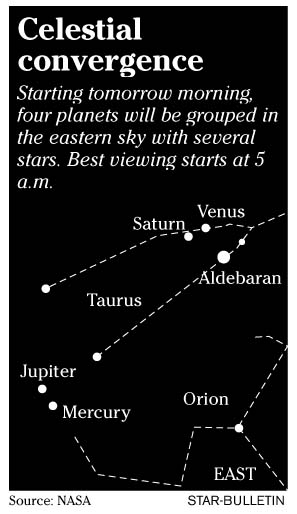

Rare planet grouping Early risers tomorrow will be treated to an unusual show in the eastern sky featuring Mercury, Venus, Jupiter and Saturn.
lights isle sky
The early-morning show
will bring 4 planets togetherBy Helen Altonn
haltonn@starbulletin.com"It's a beautiful grouping," said Mike Shanahan, Bishop Museum Planetarium manager.
A waning crescent moon will join the planets Sunday.
On Tuesday the moon will pass in front of Venus, eclipsing it, he said. "It is a fairly special event."
Residents should look in the eastern sky at about 5 a.m. tomorrow, making sure there are no trees or buildings to block the view, Shanahan said. "Over water or high on a hill would be ideal."

Venus will be bright, as usual, and will be "leading the pack," about one-third of the way between the horizon and top of the sky, he said.At the lower left, only about two degrees from Venus, will be Saturn.
Farther down in the sky will be Mercury and Jupiter.
Jupiter will be brighter than any star, but Saturn will be fainter than the other three planets, Shanahan said.
It takes Jupiter 12 years to go around the sun, and Saturn takes 30 years, "which means they creep pretty slowly in the sky," he said, "so we've got to wait 13 to 15 years to have these planets together."
Making the grouping even more interesting, he said, are the bright constellations in the background -- Orion the hunter, the Pleiades and Taurus the bull.
Aldebaran, a giant reddish-colored star, forms one eye of the bull, and "Venus is exactly where you'd expect the bull to have the other eye," he said.
Weather forecasters are predicting typical tradewind weather for tomorrow, meaning the "usual morning showers, especially over windward and mauka sections," said lead forecaster Tim Craig.
"Otherwise it should be good viewing," Craig said. "There should be nothing out of the ordinary."
The planets will shift a little day by day, with Mercury and Venus moving noticeably faster than Saturn and Jupiter, he said.
The crescent moon will enter the picture Sunday and Monday next to the Pleiades and will pass in front of Venus, blotting it out, from 5:45 to 7 a.m. Tuesday.
Although it will be light by 7 a.m., Shanahan said: "You can look at the moon and watch it uncover Venus, and you may be able to see Venus even though it's light. ... It's a good opportunity to look for it in daylight hours."
The four planets and the moon will still be visible from 5 to 5:30 a.m. Wednesday, he said, but the moon will disappear next Thursday because it will be close to a new moon.